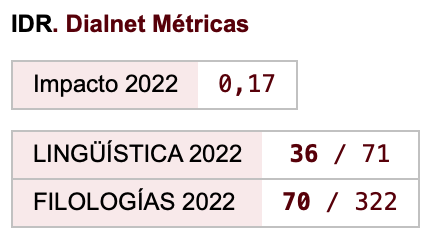Learning technologies and EFL teamwork
Keywords:
cooperation, collaboration, EFL, learning technologies, ubiquitous learningAbstract
In this article, we discuss how technology-based learning methodologies developed in primary and secondary education can offer useful approaches to higher education instruction. For example, young and adult Spanish speakers are often used to participating in discussions and debates in their English as a Foreign Language (EFL) courses. This paper highlights how this model can help support a wider collaborative, ubiquitous learning environment that supports in-class and out-of-class interactions that allow 21st century second-language learners to work with other peers in building (digital) knowledge and forming stronger arguments in English. This article emphasizes that mastering communication skills, cooperation, and collaboration through a combination of learning technologies are themselves necessary 21st century skills in today’s citizens. These capabilities can help to establish a continuous lifelong learning orientation when dealing with education at different stages of life. We will conclude that higher education assessment strategies need to be transformed in order to appreciate these collaborative, digital and EFL students’ outcomes.Downloads
References
Andreas, K., Tsiatsos, T., Terzidou, T., & Pomportsis, A. (2010). Fostering collaborative learning in Second Life: Metaphors and affordances. Computers and Education, 55(2), 603-615.
Burbules, N. C. (2004). Navigating the advantages and disadvantages of online pedagogy. In C. Haythornthwaite & M. M. Kazmer (Eds.), Learning, Culture, and Community in Online Education: Research and Practice, (pp. 3-17). New York: Peter Lang.
Burbules, N. C. (2012). El aprendizaje ubicuo y el futuro de la enseñanza. Encounters, 13, 3-14.
Burbules, N. C. (2013). Los significados de ‘aprendizaje ubicuo’. Revista de Política Educativa, 4, 11-19.
Burbules, N. C. (2014). El aprendizaje ubicuo: nuevos contextos, nuevos procesos. Revista Entramados: Educación y sociedad, 1(1), 131-135.
Cohen, E. (1994). Restructuring the classroom: Conditions for productive small groups. Review of Educational Research, 64(1), 1-35.
Cope, B., & Kalantzis, M. (Eds.). (2009). Ubiquitous learning. Champaign. IL: University of Illinois press.
Dörnyei, Z., & Kormos, J. (2000). The role of individual and social variables in oral task performance. Language Teaching Research, 4(3), 275-300.
Egea, K. (2007). Guided reflective practice for communication and collaboration: A tool for successful virtual teamwork. In P. Tseng, R. Kwang & R. Fox (Eds.), Enhancing learning through technology (pp. 82-95). Singapore: World Scientific Publishing.
García-Sánchez, S. (2014). Knowledge creation and digital collaboration in higher education. In R. Rutherford (Ed.), Collaborative learning: Theory, strategies and educational benefits, (pp. 1-14). New York: Nova Science Publishers.
García-Sánchez, S. (2015). Dealing with ESP competences: Creativity and collaboration in higher education. The International Journal of Adult, Community and Professional Learning, 22(1), 19-28.
Griffin, P., McGraw, B., & Care, E. (Eds.) (2012). Assessment and teaching of twenty-first century skills. Netherlands: Springer.
Johnson, D.W. & Johnson, R. (1994). Joining together: group theory and skills. Englewood Cliffs, New Jersey: Prentice Hall.
Kalantzis, M., & Cope, B. (2012). New learning: Elements of a science of education. Cambridge: CUP.
Kennedy, C. (2012). ESP projects, English as a global language, and the challenge of change. Ibérica: Revista de la Asociación Europea de Lenguas para Fines Específicos (AELFE),(24), 43-54.
Knapp, K. (2015). English as an International lingua franca and the Teaching of Intercultural Communication. Journal of English as a Lingua Franca, 4(1), 173-189.
Kim, C., & Pekrun, R. (2014). Emotions and motivation in learning and performance. In J. M. Spector et al. (Eds.), Handbook of research on educational communications and technology (pp. 65-75). New York: Springer.
Liu, H. (2014). Assessing language anxiety in EFL students with varying degrees of motivation. Electronic Journal of Foreign Language Teaching, 11(2), 285-299.
McComas, W. F. (2014). 21st century skills. In W. F. McComas (Ed.), The language of science education (p.1). Rotterdam: SensePublishers.
Ogata, H., & Uosaki, N. (2012). A new trend of mobile and ubiquitous learning research: Towards enhancing ubiquitous learning experiences. International Journal of Mobile Learning and Organisation, 6(1), 64-78.
Peng, H., Su, Y. J., Chou, C., & Tsai, C. C. (2009). Ubiquitous knowledge construction: Mobile learning re‐defined and a conceptual framework. Innovations in Education and Teaching International, 46(2), 171-183.
Psotka, J. (2012). Interactive learning environments. In N. Seel (Ed.), Encyclopedia of the sciences of learning (pp. 1604-1606). Verlag Berlin Heidelberg: Springer.
Sears, D. A., & Pai, H-H. (2013). Effects of cooperative versus individual study on learning and motivation after reward-removal. The Journal of Experimental Education, 80, 246-262.
Silva, E. (2009). Measuring skills for 21st-century learning. Phi Delta Kappan, 630-634.
Tomei, L. A. (2013). Top 10 technologies for designing 21st century instruction. International Journal of Information and Communication Technology Education, 9(3), 80-93.
Tucker, S. Y. (2014). Transforming pedagogies: Integrating 21st century skills and Web 2.0 technology. Turkish Online Journal of Distance Education, 15(1), 166-173.
Trilling, B., & Fadel, C. (2009). 21st century skills: Learning for life in our times. John Wiley & Sons.
Wang, A.-L. (2014). Key to developing cross-cultural collaboration: Three cases of collaborative projects. In S. Rutherford (Ed.), Collaborative learning: theory, strategies and educational benefits (pp.15-34). New York: Nova Science Publishers.
Downloads
Published
How to Cite
Issue
Section
License
Authors who publish with this journal agree to the following terms:
- Authors retain copyright and grant the journal right of first publication with the work simultaneously licensed under a Creative Commons Attribution License that allows others to share the work with an acknowledgement of the work's authorship and initial publication in this journal.
- Authors are able to enter into separate, additional contractual arrangements for the non-exclusive distribution of the journal's published version of the work (e.g., post it to an institutional repository or publish it in a book), with an acknowledgement of its initial publication in this journal.
- Authors are permitted and encouraged to post their work online (e.g., in institutional repositories or on their website) prior to and during the submission process, as it can lead to productive exchanges, as well as earlier and greater citation of published work (See The Effect of Open Access).

Revista de Lenguas para fines específicos is licensed under a Creative Commons Reconocimiento-NoComercial-SinObraDerivada 4.0 Internacional License.























